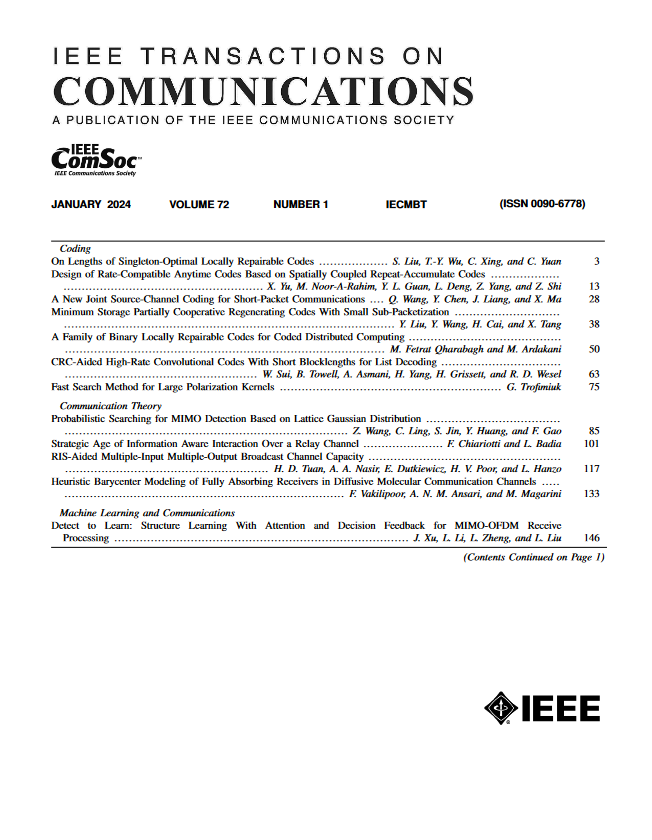上行多用户SIMO系统的信息新鲜度优化:低复杂度调度算法
IF 8.3
2区 计算机科学
Q1 ENGINEERING, ELECTRICAL & ELECTRONIC
引用次数: 0
摘要
针对上行链路多用户SIMO状态更新系统,提出了一种以信息年龄(age of information, AoI)度量为量化指标的信息新鲜度优化调度策略。多用户调度问题被表示为马尔可夫决策过程(MDP),以推导出最小化设备平均AoI的最优策略。然而,在大型网络中,由于维数的原因,最优策略的复杂度较高。为了解决这个问题,使用Lyapunov优化框架为大规模网络开发了一个低复杂性的最大权重(MW)策略。MW策略通过最大化后续时隙的预期AoI下降来动态地确定要在每个时隙中调度的设备子集。通过仿真比较了最优策略、MW策略和基线固定调度(FS)策略的性能,基线固定调度策略总是调度具有最高AoI的固定数量的设备。结果表明,该策略达到了接近最优的性能。此外,对于给定的网络设置,存在一个FS策略,其中包含可以接近MW策略的特定数量的计划设备。这种观察启发了另一种低复杂度调度策略的开发,称为优化FS (OFS)。此策略可根据特定的网络配置,进一步优化FS策略下调度的设备数量。在给定调度设备数量下,导出了FS策略的平均峰值AoI和近似平均AoI的封闭表达式,以确定不同网络设置下OFS策略的最优调度设备数量。仿真结果验证了理论分析的正确性,表明OFS策略达到了与MW策略相当的性能,同时避免了对每个时隙优化的需要。本文章由计算机程序翻译,如有差异,请以英文原文为准。
Optimizing Information Freshness in Uplink Multiuser SIMO Systems: Low-Complexity Scheduling Algorithms
This paper develops scheduling policies to optimize the information freshness, quantified by the age of information (AoI) metric, in an uplink multi-user SIMO status update system. The multi-user scheduling problem is formulated as a Markov decision process (MDP) to derive the optimal policy that minimizes the average AoI across devices. However, the optimal policy suffers from high complexity due to dimensionality in large networks. To address this, a low-complexity max-weight (MW) policy is developed for large-scale networks using the Lyapunov optimization framework. The MW policy dynamically determines the subset of devices to schedule in each time slot by maximizing the expected AoI drop of the subsequent time slot. Simulations are conducted to compare the performance of the optimal policy, the MW policy, and the baseline fixed scheduling (FS) policy that always schedules a fixed number of devices with the highest AoI. The results show that the MW policy achieves close-to-optimal performance. Moreover, for a given network setup, there exists an FS policy with a particular number of scheduled devices that can approach the MW policy. This observation inspired the development of another low-complexity scheduling policy, termed optimized FS (OFS). This policy further optimizes the number of devices scheduled under the FS policy based on specific network configurations. Closed-form expressions for the average peak AoI and the approximated average AoI of the FS policy with a given number of scheduled devices are derived to determine the optimal number of scheduled devices for the OFS policy under different network setups. Simulation results validate the theoretical analysis and show that the OFS policy achieves performance comparable to the MW policy while circumventing the need for per-slot optimization.
求助全文
通过发布文献求助,成功后即可免费获取论文全文。
去求助
来源期刊

IEEE Transactions on Communications
工程技术-电信学
CiteScore
16.10
自引率
8.40%
发文量
528
审稿时长
4.1 months
期刊介绍:
The IEEE Transactions on Communications is dedicated to publishing high-quality manuscripts that showcase advancements in the state-of-the-art of telecommunications. Our scope encompasses all aspects of telecommunications, including telephone, telegraphy, facsimile, and television, facilitated by electromagnetic propagation methods such as radio, wire, aerial, underground, coaxial, and submarine cables, as well as waveguides, communication satellites, and lasers. We cover telecommunications in various settings, including marine, aeronautical, space, and fixed station services, addressing topics such as repeaters, radio relaying, signal storage, regeneration, error detection and correction, multiplexing, carrier techniques, communication switching systems, data communications, and communication theory. Join us in advancing the field of telecommunications through groundbreaking research and innovation.
 求助内容:
求助内容: 应助结果提醒方式:
应助结果提醒方式:


